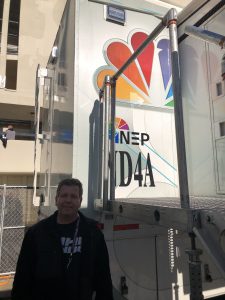Live From 2020 Winter Classic: NEP Combats Logistical Issues With Thorough Planning
The vendor’s ability to adapt to the aged confines eased a stressful task
Story Highlights
The NHL Winter Classic is always a massive undertaking for NBC Sports. With a different venue every New Year’s Day, there is no a sense of familiarity and normalcy. For the 2020 edition, the network relied on NEP Group to handle the logistical needs before and during one of its biggest festivities of the year.
“It’s a big and challenging show,” says Jim Grgurich, technical manager, NEP Group. “There’s a lot to do, and there’s not a lot of downtime, but it wasn’t compounded and made more difficult by five-degree weather and snow or rain.”
MORE FROM THE 2020 WINTER CLASSIC
- NBC Sports Turns Historic Cotton Bowl Into Hockey Heaven in Dallas
- Skycam Reaps the Benefits of Spacious, Familiar Venue
- NBC Sports’ James Stuart Breaks Down Tech Coverage at the Historic Cotton Bowl
- Photo Gallery: A Day at the NHL Winter Classic
Upgrade to Infrastructure: NEP Lays Down Fiber at the Dated Facility
As with many venues developed before the turn of this century, the Cotton Bowl pretty much lacks a modern infrastructure. A timeless classic in every sense of the word, the 90-year-old stadium presented a challenge that many of the event’s other locales haven’t.
“Most of the time,” says Grgurich, “we’re at baseball stadiums or other football stadiums [where] there’s infrastructure, transmission, triax [cable], fiber, and all the things you need for a TV show. Here, there was absolutely zero. Not one piece of fiber or copper.”
Through a subsidiary of NEP, the NHL and the broadcaster needed to do the heavy lifting by installing the necessary connectivity to produce the game.
“Bexel, a part of NEP, was hired by the league to go into the stadium ahead of time, go through all the cable and fiber, label it, and figure out where it all [goes],” Grgurich explains. “If something was broken and needed repair, they would try to fix what they could. Their job was to divvy up the resources that the stadium has [among] all the various broadcasters.”
Bexel had its hands full when it came to this hefty installation process. For NBC Sports, the company conjured up a detailed system that would allow the network to know where its equipment was in the midst of extensive cabling that belonged to other outlets in attendance.
“[For example], NBC put in a request for 20 triaxes, so Bexel broke down what they had to work with,” Grgurich says. “They went around and color-coded all the JBT boxes. Then when we actually got here, NBC knew [its] specific colors: [at] any JBT box in the stadium, [we] knew not to plug into anything that wasn’t their color.”
Out of the 16,000-17,000 ft. of fiber used, the bulk equaled 12,000 or 13,000 ft. of 72 strands. Despite having up to 10 72-strand wires running across the field, concourse, and fairgrounds, the process was quite simple.
“We had to run fiber to our outdoor host position,” says Grgurich, “so we just dropped [the signal] off the edge of the stadium. It didn’t take too long. We had pretty much maxed out the field.”
From the network’s perspective, the organizational skills of those who worked on connectivity provided a much-needed hand during inclement weather over the weekend before puck drop.
“We arrived here on Sunday morning, and, [although] it wasn’t as heavy as it was on Saturday, it was still raining,” says James Stuart, senior director, operations, NBC Sports Group. “At the end of the day, I asked one of our technicians, ‘How are we? Are we behind? Are we going to come in early tomorrow?’ And he said we were in a good spot. When you have an older venue, getting the infrastructure in early and giving the broadcaster a head start is key. Bexel did a great job.”
A Need To Roam: BSI Deploys RF Services for Mobile-Camera Shots
Along with supplying the three main mobile units for NBC Sports’ production, ND4’s A and B units plus the F4 truck for delivery purposes, another NEP subsidiary was in charge of all RF technology at the Cotton Bowl.
“BSI had three RF cameras of a different variety,” says Grgurich. “We had a standard RF handheld with a Sony HDC-2500, a MōVI RF, and a Steadicam. The MōVI and Steadicam were both Sony HDC-P1’s.”
Before the Cotton Bowl was overwhelmed by more than 85,000 fans and the additional RF congestion that came with them via cellular use, working out the RF signals to withstand a barrage of interference needed to be done.
“BSI did all of the frequency testing for it,” he says. “They generated a list of frequencies, but, between airports, Downtown Dallas, and the television channels, it was a very tight RF band.”
Leading the Way: NEP Succeeds on a Busy New Year’s Day
Putting on a holiday tradition that is viewed by millions at home takes an insane amount of preparation. In addition to the diligent work of installing the infrastructure, NEP and NBC went through a hearty rehearsal the day before to make sure that everything was running as efficiently as possible.
“We’re starting around 2:00, and it’ll go until around 6 or 7 at night,” said Grugirch on the day of the rehearsals. “Then, the NHL starts rehearsal for introductions of the teams. [Sometimes], we’ve done four hours, and, other times, we’ve done an hour.”
On the same day as the Winter Classic, the company played a role in another NBC broadcast: the Tournament of Roses Parade in Pasadena, CA.
“We do a cut into the parade,” he explains. “We had a rehearsal for that because the Rose Parade is such a big production.”
Grgurich, at his 10th Winter Classic, and his team focused their attention and efforts in Dallas. “For [our] hockey [coverage], this is huge,” he says. “As for other shows that NEP does, it’s not as big as a Super Bowl, but it’s a pretty big production.”


